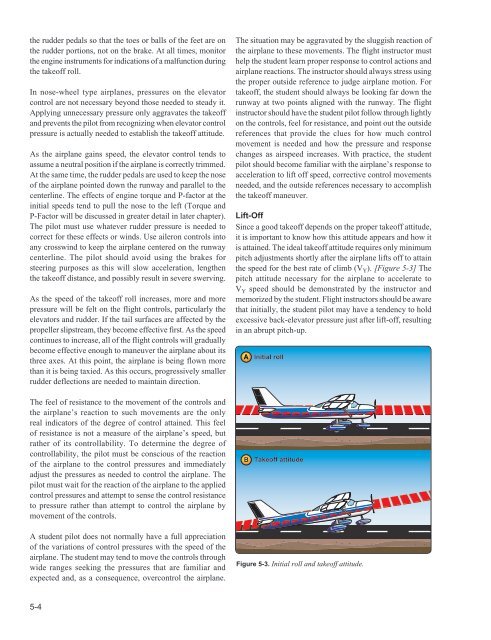You also want an ePaper? Increase the reach of your titles
YUMPU automatically turns print PDFs into web optimized ePapers that Google loves.
the rudder pedals so that the toes or balls of the feet are on<br />
the rudder portions, not on the brake. At all times, monitor<br />
the engine instruments for indications of a malfunction during<br />
the takeoff roll.<br />
In nose-wheel type airplanes, pressures on the elevator<br />
control are not necessary beyond those needed to steady it.<br />
Applying unnecessary pressure only aggravates the takeoff<br />
and prevents the pilot from recognizing when elevator control<br />
pressure is actually needed to establish the takeoff attitude.<br />
As the airplane gains speed, the elevator control tends to<br />
assume a neutral position if the airplane is correctly trimmed.<br />
At the same time, the rudder pedals are used to keep the nose<br />
of the airplane pointed down the runway and parallel to the<br />
centerline. The effects of engine torque and P-factor at the<br />
initial speeds tend to pull the nose to the left (Torque and<br />
P-Factor will be discussed in greater detail in later chapter).<br />
The pilot must use whatever rudder pressure is needed to<br />
correct for these effects or winds. Use aileron controls into<br />
any crosswind to keep the airplane centered on the runway<br />
centerline. The pilot should avoid using the brakes for<br />
steering purposes as this will slow acceleration, lengthen<br />
the takeoff distance, and possibly result in severe swerving.<br />
As the speed of the takeoff roll increases, more and more<br />
pressure will be felt on the flight controls, particularly the<br />
elevators and rudder. If the tail surfaces are affected by the<br />
propeller slipstream, they become effective first. As the speed<br />
continues to increase, all of the flight controls will gradually<br />
become effective enough to maneuver the airplane about its<br />
three axes. At this point, the airplane is being flown more<br />
than it is being taxied. As this occurs, progressively smaller<br />
rudder deflections are needed to maintain direction.<br />
The situation may be aggravated by the sluggish reaction of<br />
the airplane to these movements. The flight instructor must<br />
help the student learn proper response to control actions and<br />
airplane reactions. The instructor should always stress using<br />
the proper outside reference to judge airplane motion. For<br />
takeoff, the student should always be looking far down the<br />
runway at two points aligned with the runway. The flight<br />
instructor should have the student pilot follow through lightly<br />
on the controls, feel for resistance, and point out the outside<br />
references that provide the clues for how much control<br />
movement is needed and how the pressure and response<br />
changes as airspeed increases. With practice, the student<br />
pilot should become familiar with the airplane’s response to<br />
acceleration to lift off speed, corrective control movements<br />
needed, and the outside references necessary to accomplish<br />
the takeoff maneuver.<br />
Lift-Off<br />
Since a good takeoff depends on the proper takeoff attitude,<br />
it is important to know how this attitude appears and how it<br />
is attained. The ideal takeoff attitude requires only minimum<br />
pitch adjustments shortly after the airplane lifts off to attain<br />
the speed for the best rate of climb (V Y ). [Figure 5-3] The<br />
pitch attitude necessary for the airplane to accelerate to<br />
V Y speed should be demonstrated by the instructor and<br />
memorized by the student. Flight instructors should be aware<br />
that initially, the student pilot may have a tendency to hold<br />
excessive back-elevator pressure just after lift-off, resulting<br />
in an abrupt pitch-up.<br />
A<br />
Initial roll<br />
The feel of resistance to the movement of the controls and<br />
the airplane’s reaction to such movements are the only<br />
real indicators of the degree of control attained. This feel<br />
of resistance is not a measure of the airplane’s speed, but<br />
rather of its controllability. To determine the degree of<br />
controllability, the pilot must be conscious of the reaction<br />
of the airplane to the control pressures and immediately<br />
adjust the pressures as needed to control the airplane. The<br />
pilot must wait for the reaction of the airplane to the applied<br />
control pressures and attempt to sense the control resistance<br />
to pressure rather than attempt to control the airplane by<br />
movement of the controls.<br />
B<br />
Takeoff attitude<br />
A student pilot does not normally have a full appreciation<br />
of the variations of control pressures with the speed of the<br />
airplane. The student may tend to move the controls through<br />
wide ranges seeking the pressures that are familiar and<br />
expected and, as a consequence, overcontrol the airplane.<br />
Figure 5-3. Initial roll and takeoff attitude.<br />
5-4


